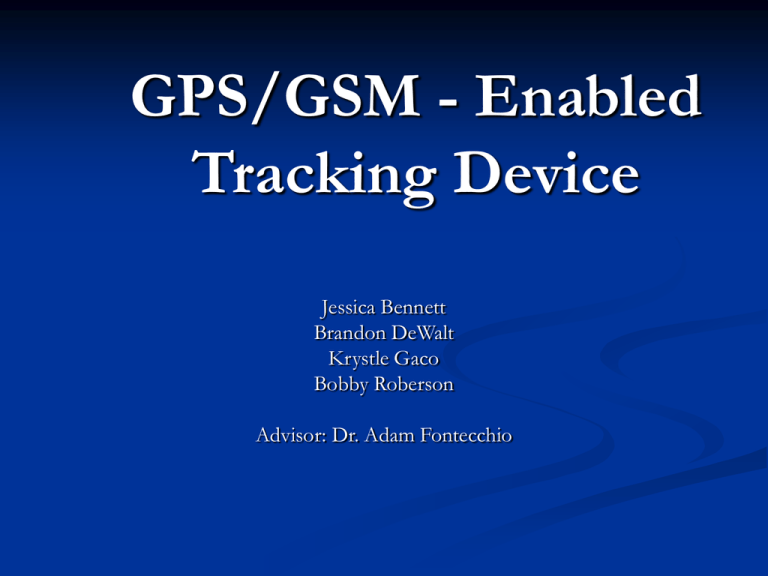Strategies to Reduce the Volume of Lost Luggage
advertisement

GPS/GSM - Enabled Tracking Device Jessica Bennett Brandon DeWalt Krystle Gaco Bobby Roberson Advisor: Dr. Adam Fontecchio Overview of Solution Our project analyzes luggage loss in the status quo and provides a solution to remedy this problem. Our solution is a device that operates on the Global Positioning System (GPS) and the Global System for Mobile Cmmunication (GSM) to provide customers with the location of their luggage. Problem Background 7 million bags misplaced in 2006 (McCartney) $400 million cost to airlines annually (McCartney) Increase in number of misplaced bags by all airlines in 2006 Percentage Increase of Lost Luggage, 2005 Year-over-year increase (%) 90 81 80 70 60 50 37 40 27 25 30 15 20 10 15 9 9 America West Airlines United Airlines 0 US Airways Delta Air Lines American Airlines Northwest Airlines Southwest Airlines Continental Airlines Percentage increase of lost luggage in 2005 over 2004 (Adams 2006). Problem Background Barcode tags are source of problem Damage to barcode tag reduces accuracy to 80% or less Large numbers of bags must be manually scanned <http://www.worldmagblog.com/blog/lostluggage.jpg>. Possible Solutions RFID system for airports More durable barcode tags GPS/GSM enabled device Current vehicle/asset tracking devices cost $200$500 Our Solution Utilizes GPS and GSM Lithium-Polymer Battery No display Antenna USB port for updates Built-in charger Images created by Bobby Roberson are digital modifications of musicPower™ charging device Targeted Demographic Market product to airline passengers with sports equipment Purpose of Air Travel 60 50.5 Percentage of Total 50 40.6 40 30 20 8 10 0.9 0 Business Pleasure/Leisure Personal Other Source: 2001 National Household Travel Survey, Bureau of Transportation Statistics Our Solution Market product to airline passengers with sports equipment Passengers likely to buy device to keep track of their high-value item(s) GSM (Global System for Mobile Communications) Established in 1980s Composed of three systems Switching (calls and subscription services) Base (radio interfacing and mobile station) Operation and support system (monitors and controls system) Message center Short message service for text or data messages sent over the network Information above courtesy of John Scourias, University of Waterloo https://styx.uwaterloo.ca/~jscouria/GSM/gsmreport.html Global GSM Coverage GPS (Global Positioning System) Under control of United States Department of Defense 24 satellites available, plus 3 backups GPS chip receives signal from 3 satellites (2-D) Frequency – 1575.42 MHz (Dana) http://www.colorado.edu/geography/gcraft/notes/gps/gps_f.html How GPS Works Location is determined from very precise atomic clocks in the satellites Receiver calculates location based upon time delay and location of satellite http://www.colorado.edu/geography/gcraft/notes/gps/gps_f.html Operation of Device Turns on once per hour Attempts to connect to GSM Network Must be within 25 miles of a tower Sends location via text message to database Otherwise, switches to GPS then transmits location Device returns to sleep mode Our Solution Constraints Power (VALUE) Size Interference with plane systems Cost of components Permission to use GSM towers Image created by Bobby Roberson is digital modification of musicPower™ charging device Our Solution Criteria Cost less than $50 per device Operate for 7+ days on battery power Durable, reusable, rechargeable No larger than 3”x2”x1” Less than 0.5 lb Must not interfere with communication systems Cost Breakdown u-Nav uN9518 GSM/GPS chipset Power Stream Lithium-Polymer battery Antenna Protective Casing (plastic) Hirose UX60A-MB-5ST USB receptacle Production Costs Projected Profit Marketing Costs 10,000 lifetime text messages Total Cost $46.06 $8.50 $1.37 $0.75 $1.50 $0.44 $7.50 $10.00 $4.00 $12.00 Environmental Impacts Manufacture of components contributes to environmental damage Mostly lead-free, halogen-free and RoHS compliant parts Reusable, rechargeable (500,000 units)(0.5lb)(5 year lifetime) = 50,000 lb added to waste stream each year Future Work Market product to all demographics Business and vacationers in first year International market in five years Develop company to provide rentals via mail for shipping Acknowledgments Dr. Adam Fontecchio, Drexel University Tom Juliano, SiRF Rick Lockwood, u-Nav Microelectronics References 28 Dec. 2004. 15 Feb. 2007 <http://www.worldmagblog.com/blog/lostluggage.jpg>. Adams, Marilyn. (2006, February 16). Airlines Lost 10,000 Bags a Day in ’05. Retrieved February 15, 2007, from the USA Today website: http://www.usatoday.com/money/biztravel/2006-02-16-lostbags-usat_x.htm Dana, Peter H. "The Global Positioning System." The Geographers Craft. 1 May 2000. University of Colorado. 28 Apr. 2007 <http://www.colorado.edu/geography/gcraft/notes/gps/gps_f.html>. "Global System for Mobile Communication (GSM)." Web ProForums. International Engineering Consortium. 1 May 2007 <http://www.iec.org/online/tutorials/gsm/topic05.html/>. McCartney, Scott. (2007, February 27). The Middle Seat: A New Way to Prevent Lost Luggage. Retrieved February 27, 2007, from the Wall Street Journal, February Scourias, John. (1994). “Overview of the Global System for Mobile Communications.” University of Waterloo. Retrieved 8 May 2007. <https://styx.uwaterloo.ca/~jscouria/GSM/gsmreport.html> 27, 2007.


